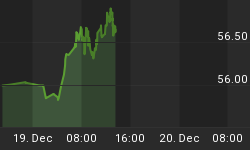Below is an extract from a commentary posted at www.speculative-investor.com on7th November 2004.
Albert Einstein said that we should make things as simple as possible, but no simpler. And when it comes to the stock market, you could have interpreted the intermediate-term trend with considerable accuracy over the past several years simply by knowing one thing: that the NASDAQ100 Index (NDX) moves higher relative to the Dow during the upward trends and moves lower relative to the Dow during the downward trends. By the same token, if you didn't know this simple guideline then you would probably have been completely wrong-footed by the market on multiple occasions, particularly if you made the mistake of focusing on the absolute behaviour of the Dow Industrials Index (the Dow tends to show relative strength near intermediate-term tops and relative weakness near intermediate-term bottoms, so someone who puts a lot of weight on what the Dow is doing will probably be too bullish near the tops and/or too bearish near the bottoms).
Actually, it hasn't been necessary to monitor the performance of the NDX relative to the Dow to properly interpret 'the trend', but it has been necessary to understand that the most important influence on the stock market's 3-12 month trend is whether market participants are becoming more or less risk averse (NDX/Dow is just one way of measuring changes in investors' preference for risk). For example, if the performance of the US stock market during the late-1990s taught us anything it was that there is no limit on how over-priced a market can become provided that the risk tolerance of 'investors', as a group, is increasing.
Now, over the remainder of this decade the US stock market will almost certainly not experience anything like the total disregard for risk demonstrated by the buyers of telecom, tech and internet stocks during 1998-2000, but there will be extended periods when the market trends higher despite terrible fundamentals simply because, rightly or wrongly, people start to perceive a brighter future and become less risk averse. And the NDX/Dow ratio should continue to be a good leading indicator of the market's intermediate-term trend as long as the stocks that comprise the NDX are generally thought to be more risky than the stocks that comprise the Dow.
The ability of the NDX/Dow ratio to define the intermediate-term trend in the US stock market, particularly since the 'bubble peak' during the first quarter of 2000, is illustrated by the below chart comparison of the S&P500 Index and NDX/Dow. Note, with reference to the below chart, that every intermediate-term rally in the S&P500 over the past several years was accompanied by a rally in NDX/Dow and every intermediate-term decline in the S&P500 was accompanied by a downward trend in NDX/Dow. Furthermore, although it might not be readily apparent from the below chart it is significant that NDX/Dow has LED the S&P500 at most of the important turning points.

The above chart shows that NDX/Dow was essentially trendless from the beginning of this year until early September, which explains why it was so difficult to get a handle on the market's intermediate-term trend during the first 8 months of the year. In other words, one reason it's been such a frustrating year for bulls AND bears is that this simple indicator did not, prior to the past two months, provide any clear signals. There were a couple of times when a breakdown appeared to have occurred, most notably during the first half of August, but in each case there was no follow-though.
However, over the past two months the NDX/Dow ratio has provided a clear signal and the signal is bullish. This wasn't, by the way, the only signal that a bullish trend was developing; it was just the most important one as far as we were concerned.
The fact that a bullish signal occurred made (and still makes) very little sense to us, but it would have made even less sense for us to ignore the clear signs that the short- and intermediate-term outlooks were becoming more positive. We therefore switched from 'intermediate-term bearish' to 'intermediate-term neutral' on 8th September and from 'short-term bearish' to 'short-term bullish' on 27th October (2 days after the Dow's final low for the year). It's possible that we will upgrade our intermediate-term outlook to bullish within the next two weeks, but the fact that we haven't yet done so reflects some on-going uncertainty with regard to the longevity of the rally. Specifically, while the market appears to be headed higher into January of 2005 we suspect that the January high could turn out to be the high for the year because the monetary and fiscal backdrops during 2005-2006 are likely to be far less friendly than they have been over the past two years.















